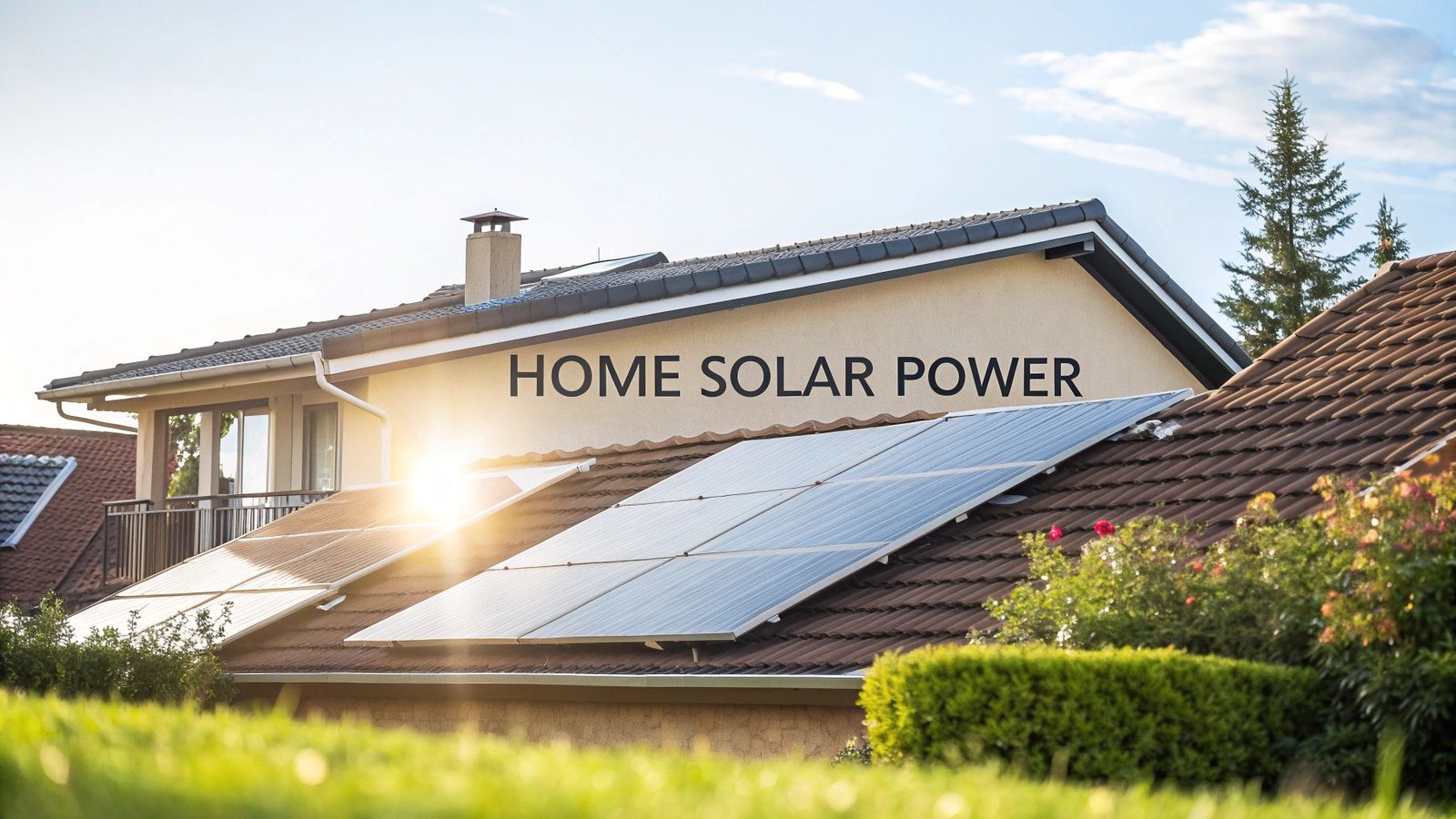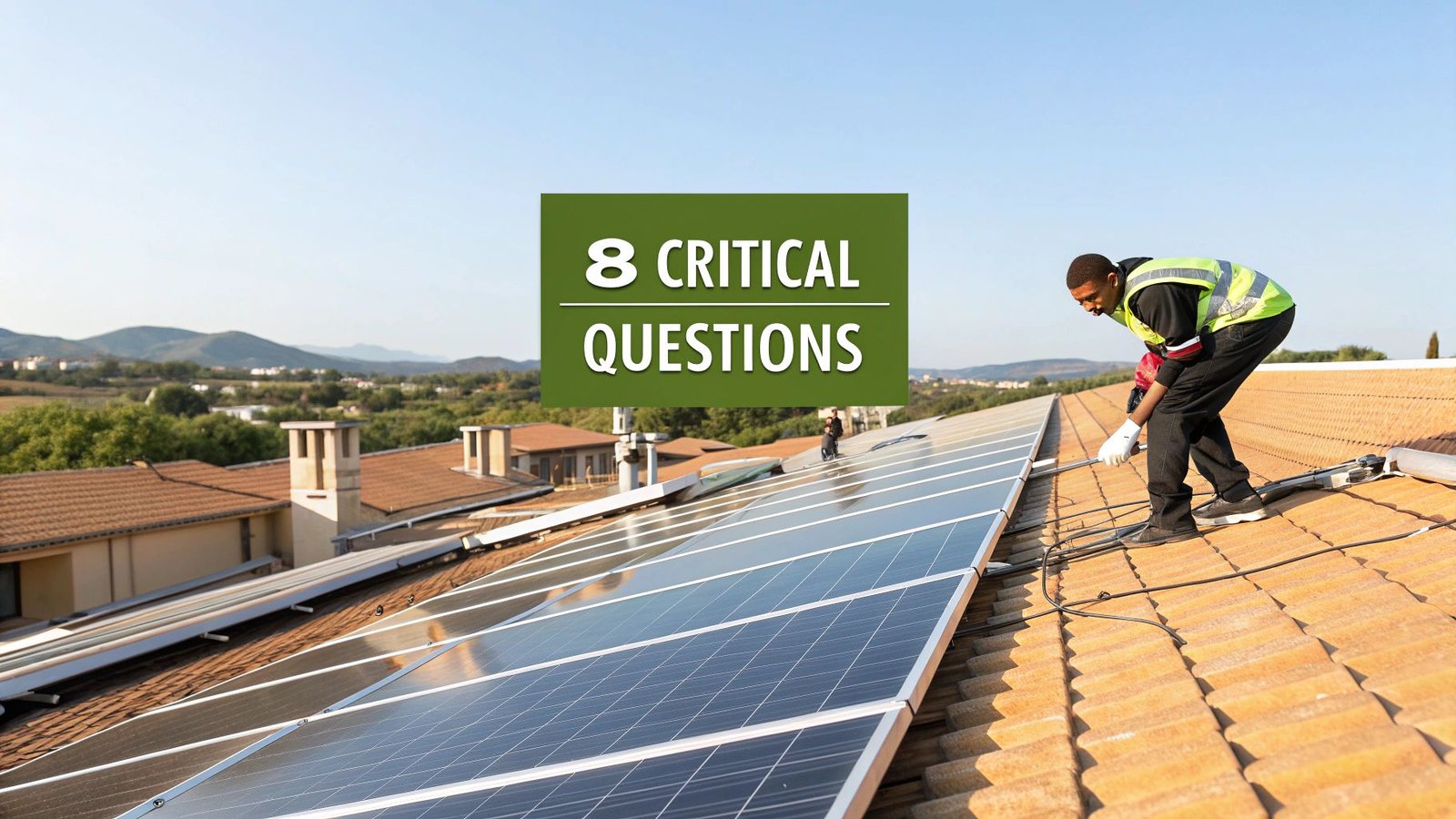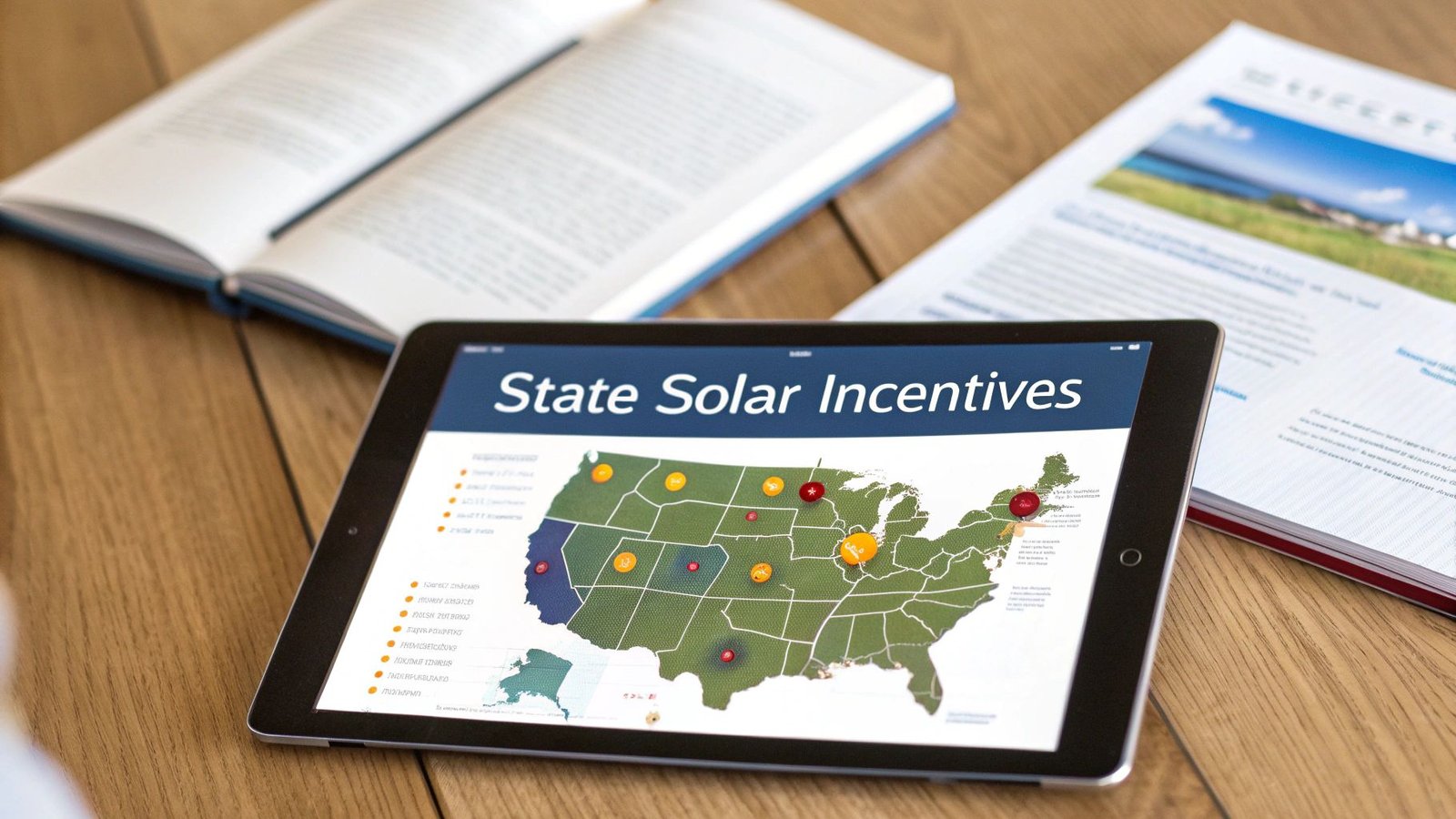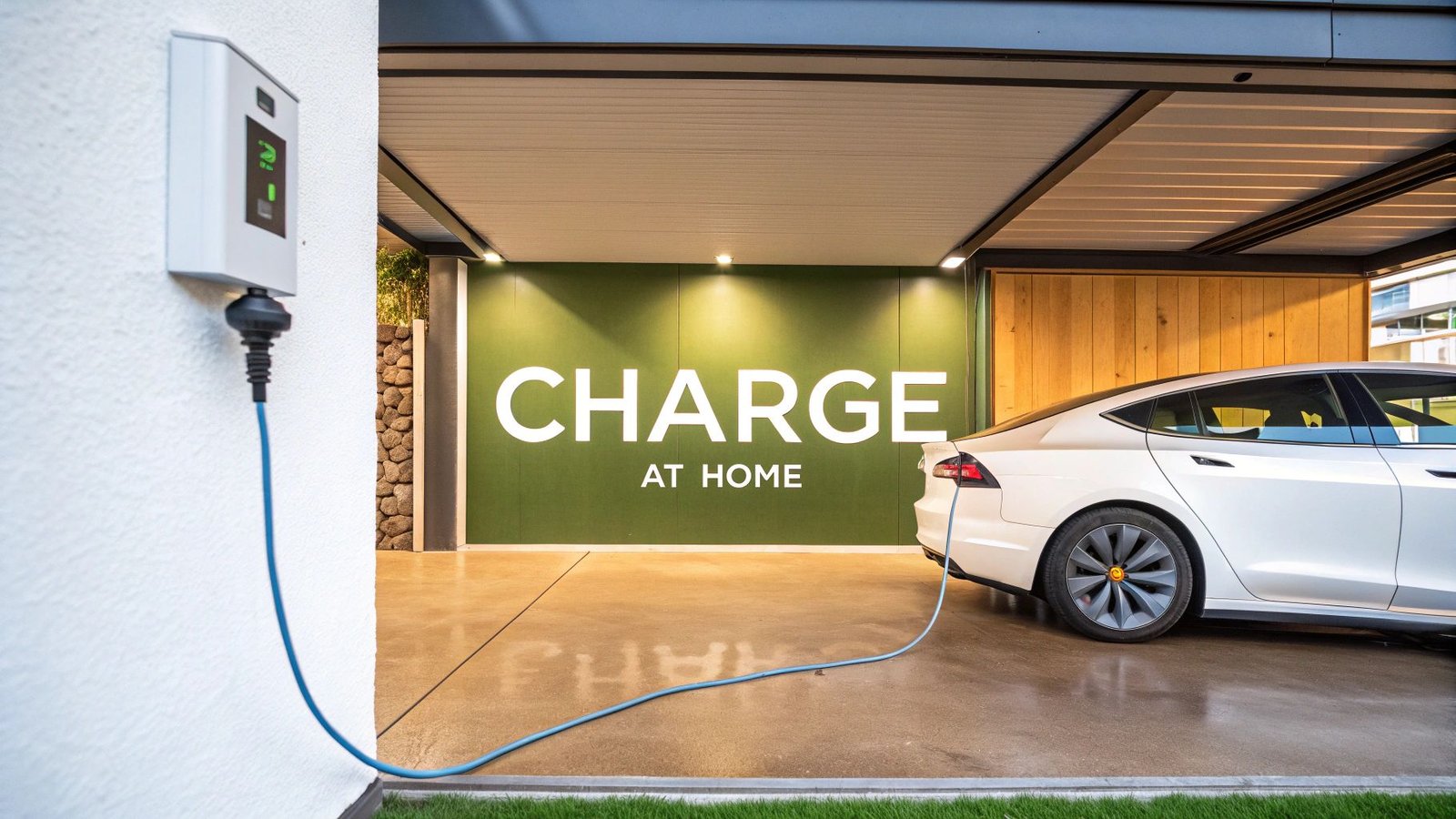At its most basic level, solar energy works by turning sunlight directly into electricity using what are known as photovoltaic (PV) panels. You can think of a solar panel as a kind of high-tech leaf for your house; it soaks up photons from the sun and uses that energy to get an electrical current flowing. From there, a device called an inverter steps in to transform that current into the power your home can actually use.
From Sunbeam to Socket: How Solar Powers Your Home
Ever looked up at a solar panel and wondered what's really going on inside? The journey a single sunbeam takes to power your coffee maker is a fascinating bit of science, but it’s actually pretty straightforward when you break it down. It’s a clean, silent process that unfolds on your rooftop every single day the sun is shining.
Getting a handle on this journey is the first real step toward understanding how solar can create true energy independence for your home. The whole magic trick of turning sunlight into usable electricity happens in three key stages. Each one has a specific job, and they all have to work together perfectly to get power flowing to your outlets.
The Three Stages of Solar Power
Let's walk through the entire process, from the sun hitting your roof to you flipping on a light switch. This simple flow is the heart of how residential solar works.
- Capture: It all starts with the solar panels on your roof. They are designed to absorb particles of light from the sun, which are called photons.
- Creation: When these photons hit the solar cells inside the panel, they knock electrons loose from their atoms. This creates a flow of electricity known as direct current, or DC electricity.
- Conversion: That raw DC electricity then travels to a box called an inversor, which is essentially the brains of your solar system. The inverter’s job is to convert that DC power into alternating current (AC) power—the standard electricity that all of your home’s appliances and electronics are built to run on.
This three-step dance is the fundamental principle behind every home solar power system.
At its heart, the process is a beautiful piece of physics put to practical use. Sunlight provides the fuel, the panel creates the initial spark, and the inverter delivers the final, usable product.
This chart gives you a simple, at-a-glance summary of that journey.
The Three Key Stages of Solar Energy Conversion
A simplified breakdown of how sunlight is transformed into the electricity that powers your daily life.
| Stage | What Happens | Key Component Involved |
|---|---|---|
| Capture | Sunlight (in the form of photons) strikes the panel. | Solar Panels (Photovoltaic Cells) |
| Create | Photons dislodge electrons, creating a flow of DC electricity. | Solar Cells (typically made of silicon) |
| Convert | The raw DC electricity is changed into usable AC electricity. | The Inverter |
Once the inverter does its job, that clean, sun-powered AC electricity is ready to go. It flows right into your home's electrical panel and is distributed to all your outlets and appliances, just like the power you’d normally get from the utility grid.
The Magic of Solar Cells: The Photovoltaic Effect
To really get how solar energy works, we have to look past the rooftop panel and zoom way down to the microscopic level. This is where the real science unfolds, in a process known as the photovoltaic effect. It sounds technical, but the concept is actually pretty straightforward.
Think of it like a game of cosmic pinball happening inside every solar cell.
At the center of it all are materials called semiconductors—silicon is the most common one you'll find. Now, picture sunlight as a constant stream of tiny energy packets called photons. When these photons zip down from the sun and smash into the silicon atoms in a solar cell, they transfer their energy.
This jolt of energy is just enough to knock an electron loose from its atom. These freed-up electrons are the key to creating an electrical current. But simply freeing them isn't enough; they need some direction to create a steady flow of electricity we can actually use.
Creating an Electron Slide
This is where the clever engineering comes in. Solar cell manufacturers build a specific structure inside the cell to give those electrons a path to follow. They treat the silicon with other elements in a process called doping, which creates two distinct layers and a permanent electrical field.
- One layer, the N-type (negative), is given an excess of electrons.
- The other layer, the P-type (positive), is created with a shortage of electrons, leaving "holes" that electrons are naturally drawn to.
The boundary where these two layers meet is called the P-N junction. This junction is the secret sauce. It acts like a one-way street, creating an "electron slide" that forces all the newly freed electrons to move in the same direction.
So, when a photon strikes the cell and frees an electron, this built-in electrical field immediately shoves it toward the N-type layer. This organized, one-way parade of countless electrons is what we call an electric current—specifically, direct current (DC).
This visual breaks down the simple three-step journey from sunlight hitting the panel to creating power for your home.
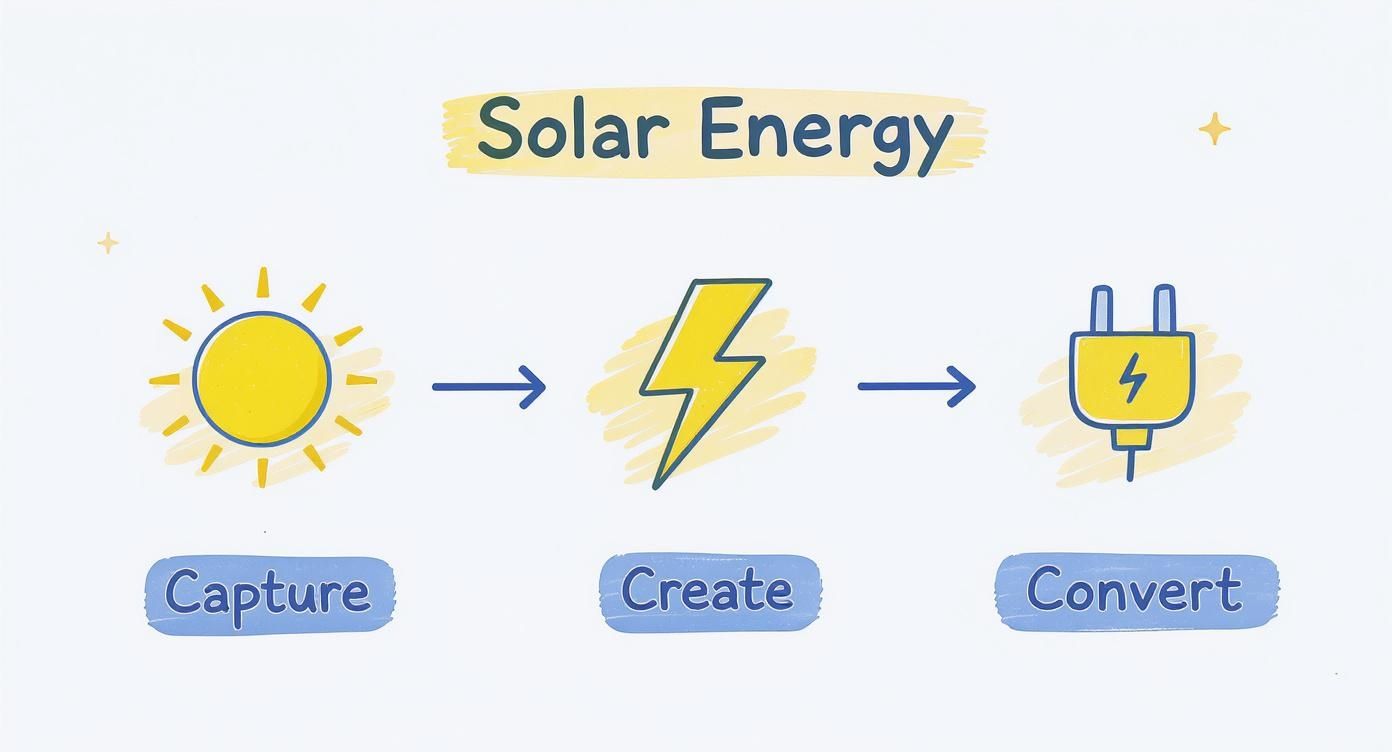
This process—capturing photons, creating a current, and converting it—is all made possible by the quiet, powerful physics of the photovoltaic effect.
From a Single Cell to a Powerful Panel
Of course, a single solar cell doesn't generate much power on its own. To produce enough electricity for a house, manufacturers wire dozens of these individual cells together into the single module we recognize as a solar panel. You can get a closer look at the different componentes de un panel solar en nuestra guía detallada.
Thin metal plates on the front and back of the cells act like collectors, gathering all the electrons that have been set in motion. From there, the electrons flow through the wires connecting all the cells, combining to form a much stronger current.
This collective current from the entire panel then flows out and heads to the system's inverter. Without the elegant physics of the photovoltaic effect happening billions of times per second across every cell, none of this would work. It's the silent, solid-state engine that turns simple sunlight into clean, reliable power. And because it all happens with no moving parts, solar panels are incredibly durable and built to last for decades.
Anatomy of a Home Solar System: The Key Players
We've seen how a single solar cell works its magic, but one cell won't power your TV. To understand how solar works for your entire house, you have to look at the whole system—a team of components working together to bring clean energy from the sun to your outlets.
Thinking of it as a team really helps. Each player has a specific job, from catching sunlight to making that energy useful for your daily life. Together, they create a seamless flow of electricity for your home.

The Energy Collectors: Solar Panels
The most obvious part of any system is the solar panels (also called PV modules). Their job is straightforward but essential: they’re the energy collectors. Placed on your roof, they soak up sunlight all day long and, using the photovoltaic effect, turn that light into direct current (DC) electricity.
These panels are the frontline workers of your personal power plant. They’re built tough, designed to endure decades of rain, snow, and sun while quietly doing their job. The number of panels you have dictates how much power your system can generate at its peak.
The System's Translator: The Inverter
So, the panels make DC electricity, but there’s a problem—your house doesn’t use DC. Your appliances run on alternating current (AC). This is where the inversor steps in. It’s the brains of the operation.
The inverter’s main job is converting that raw DC power from the panels into the AC power your home can actually use. Think of it as a translator, allowing the solar energy to "speak the language" of your refrigerator and lights. To dig deeper, check out our guide on https://radiantenergysolar.com/what-is-a-solar-inverter/. Every single kilowatt-hour you get from the sun passes through this device first.
The Foundation: The Mounting System
It’s easy to overlook, but the sistema de montaje (or racking) is what holds everything together. This is the heavy-duty framework that secures the solar panels to your roof. It's engineered not just to hold the panels firmly in place, but to angle them perfectly for maximum sun exposure.
Before any installation, it’s a smart move to get a professional roof inspection to make sure your roof is ready for the job. A rock-solid mounting system is what ensures your investment stays safe and productive for the 25+ year lifespan of the panels.
The Backup Plan: Energy Storage
Solar batteries aren't in every system, but they are a game-changer for anyone wanting true energy independence. A battery is like your own private energy reserve. During the day, any extra solar power your panels make—power your home isn't using at that moment—gets stored in the battery.
By storing this surplus power, you can tap into clean solar energy at night, on cloudy days, or even during a blackout. This is the key to unlocking 24/7 power from the sun.
This stored energy provides peace of mind and more control over your power, which is why batteries are becoming such a popular addition to modern solar setups. We'll explore how they work in more detail next.
Storing Sunshine: The Role of Solar Batteries
Solar panels are fantastic at generating power when the sun is shining, but what happens when it isn't? At night, during a storm, or simply on a heavily overcast day, your production is going to dip. This is where the real journey to energy independence begins, and it’s all thanks to solar batteries.
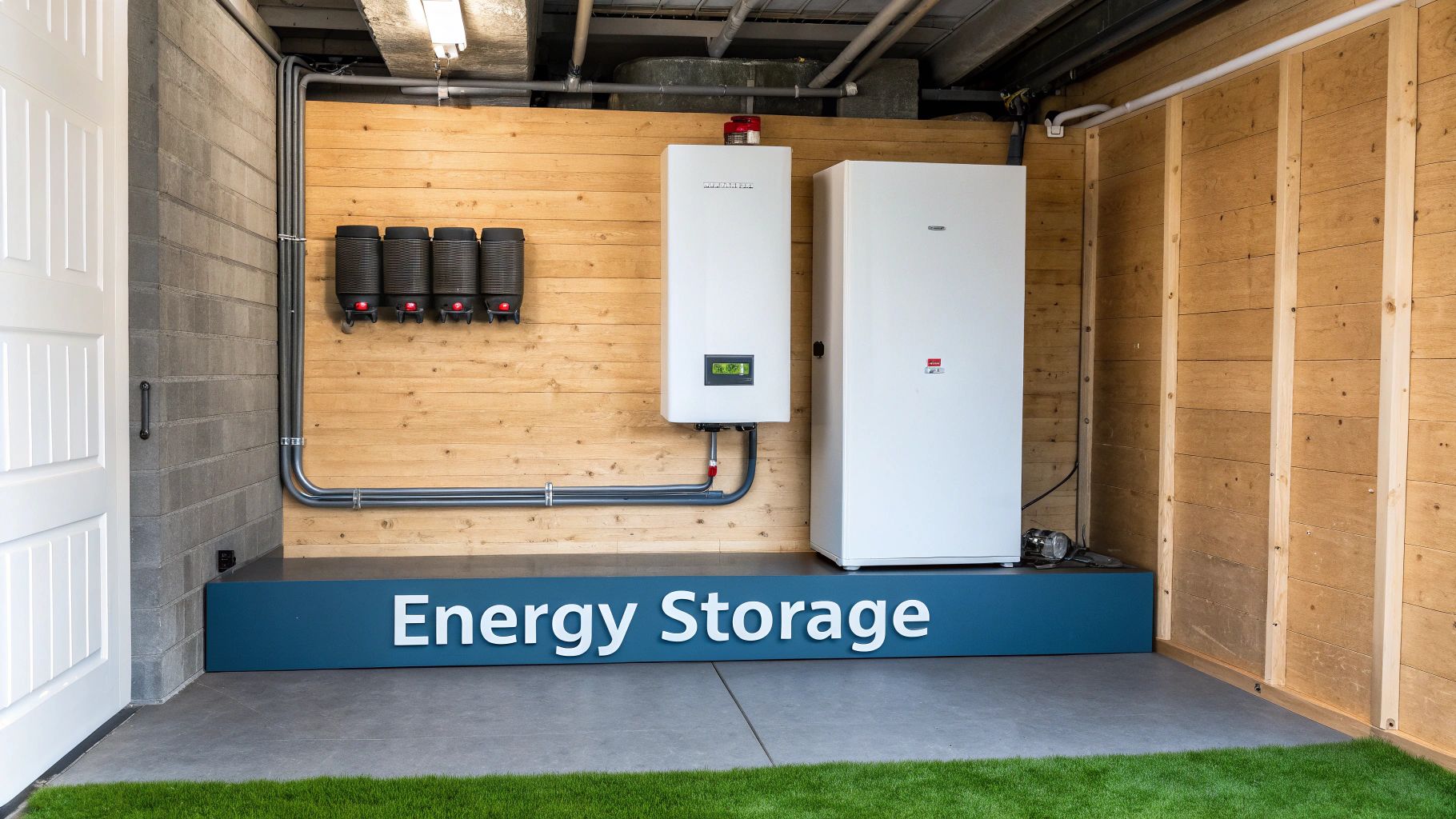
Without a battery, any extra electricity your panels generate during the day just gets sent back to the grid. A solar battery completely changes that equation. It lets you capture and save that surplus energy for later, ensuring you’re running on sunshine long after the sun has set.
Your Personal Energy Reservoir
The easiest way to think about a solar battery is like a water tank for your home's electricity. During the sunniest parts of the day, your panels often produce way more power than you’re using. Instead of letting that valuable energy go to waste, the battery "fills up," storing it as chemical energy.
Then, when the sun goes down and your panels go dormant, your home automatically starts drawing power from this reservoir. The switch is totally seamless. You won't even notice it happened, but your lights, appliances, and devices will keep running on clean solar power, day or night. This ability to power yourself is the core of how to store solar energy for 24/7 reliability.
A solar battery transforms your system from a part-time power producer into a full-time energy solution. It's the key to maximizing your solar investment and minimizing your reliance on the utility grid.
Understanding Battery Specs
When you start looking at solar batteries, you'll constantly see two key terms: capacity y power rating. They might sound similar, but they measure very different, very important things.
- Capacity (kWh): This tells you how much total energy the battery can hold, measured in kilowatt-hours (kWh). Just think of this as the size of your energy tank. A 10 kWh battery, for instance, could power a 1-kilowatt appliance for a full 10 hours.
- Power Rating (kW): This measures how much electricity the battery can deliver at any single moment, measured in kilowatts (kW). This is like the size of the tank's faucet. A high power rating means the battery can run several big, power-hungry appliances all at once.
Getting the right setup means finding the right balance between these two specs to match how your household actually uses electricity.
Comparing System Setups
Adding a battery fundamentally changes your relationship with your energy. It’s not just about savings anymore; it’s about resilience and having crucial backup power when you need it most.
To make this clear, let's compare how a standard solar system functions versus one that's paired with battery storage.
Grid-Tied Solar vs Solar with Battery Storage
| Característica | Standard Grid-Tied System | Solar System with Battery |
|---|---|---|
| Nighttime Power | Draws power from the utility grid. | Draws power from stored solar energy. |
| Grid Outages | System shuts down for safety; no power. | Can provide backup power to your home. |
| Energy Control | You use solar power as it's generated. | You store excess solar for use anytime. |
| Grid Reliance | High reliance, especially at night. | Significantly reduced reliance on the grid. |
In the end, what a battery really gives you is control. It ensures the clean energy you generate actually stays in your home, ready for you to use whenever you need it. That's a powerful tool for both energy independence and peace of mind.
What Really Affects Your Solar Panel Performance?
Knowing how a solar cell works on a technical level is one thing, but what happens when you put it on a real roof in the real world? The amount of electricity your system generates from one day to the next isn't just a lab measurement; it's influenced by a handful of practical, everyday variables.
Think of it like tending a garden. A garden's success depends on its location, the weather, and whether it gets enough sun. A solar panel’s output is tied just as directly to its environment. That's why setting up panels isn't just about finding an empty spot on the roof—it's a strategic process. A good installer carefully considers every factor that could help or hinder your system’s ability to capture sunlight. Getting these details right is what makes a solar investment truly pay off.
Location and Sun Hours
The biggest single factor determining your solar output is, unsurprisingly, where you live. A home in sunny Arizona will naturally get more horas punta de sol—the time when sunlight is most intense—than one in a cloudier city like Seattle. This number is the bedrock of any solar production estimate.
Simply put, more sun hours mean more kilowatt-hours of clean energy. It’s a direct relationship. Even within the same town, some homes might get a bit more direct sunlight than others just based on local hills or buildings.
You can't change your home's location, but understanding your area's average sun hours is the first step in setting realistic expectations for what your system can produce each year.
This chart shows just how much average daily sun hours can vary across different U.S. cities, which has a huge impact on a system's potential.
Average Daily Peak Sun Hours by City
| City | Average Daily Sun Hours |
|---|---|
| Phoenix, AZ | 6.5 – 7.5 |
| Miami, FL | 5.0 – 5.5 |
| Denver, CO | 5.5 – 6.0 |
| Chicago, IL | 4.0 – 4.5 |
| Seattle, WA | 3.5 – 4.0 |
Data represents typical yearly averages and can fluctuate.
Roof Direction and Angle
The way your roof is pointed makes a massive difference. Here in the Northern Hemisphere, south-facing roofs are the gold standard because they get the most direct, consistent sunlight throughout the day. East-facing roofs are great for catching morning sun, while west-facing roofs are powerhouses in the afternoon.
En inclinación, or angle, of the panels is just as important. The sweet spot is an angle that roughly matches your home's latitude. This lets the panels face the sun as directly as possible all year long. A perfectly positioned array can generate up to 25% more electricity than one that's poorly placed.
Shading and Other Obstacles
Even with the best roof in the world, a single shadow can throw a wrench in the works. A tall tree, a neighbor’s chimney, or even a small vent pipe on your own roof can cast shadows that slash your system's output.
Modern systems have gotten much better at handling this, often using microinverters or optimizers to minimize losses from partial shading. Still, the best strategy is always to avoid shade in the first place.
Weather also plays its part. Panels absolutely work on cloudy days, but their output will be lower. Here's a surprising fact: extreme heat can actually make solar panels slightly less efficient. They love sun, but they perform at their absolute best in bright, cool conditions. That's why a sunny spring day can sometimes generate more power than a blistering hot one in August.
Solar Power's Place in Our Global Energy Future
It's one thing to understand how solar panels work on your own roof, but the real story unfolds when you zoom out. Choosing solar for your home is more than just a personal energy decision—it’s you plugging into a massive global shift toward cleaner, more resilient power. This isn't just wishful thinking; it's a movement driven by hard numbers, undeniable cost reductions, and some incredible leaps in technology.
The growth of solar power across the world has been nothing short of astonishing. What was once a niche technology for off-grid enthusiasts is now a central pillar in our global energy strategy. Countries are adopting solar at a breakneck pace, building sprawling solar farms and encouraging rooftop installations on a scale that would have seemed like science fiction just a decade ago.
The Accelerating Pace of Global Adoption
So, what’s lighting a fire under this global adoption? It really boils down to two things: economics and a collective environmental conscience. The cost of solar panels has absolutely plummeted over the past decade, making solar one of the cheapest—if not el cheapest—ways to generate new electricity in many parts of the world. This has kicked off a fantastic feedback loop: the more people and governments invest in solar, the more manufacturing scales up, which in turn drives costs down even further.
When you install a solar system, you're not just an energy consumer anymore. You're joining a global community that is actively building a more sustainable energy infrastructure, one rooftop at a time. Your system contributes to a larger grid that is slowly but surely becoming cleaner and less reliant on fossil fuels.
The numbers tell a powerful story. Global solar generation hit an incredible 2,129 terawatt-hours (TWh) in just 11 years, which is the fastest growth of any electricity source in history. This boom pushed the total installed PV capacity past 2,2 teravatios (TW) by the end of 2024, a huge jump from 1.6 TW in 2023. You can get a deeper look at this bright outlook for solar on the Goldman Sachs insights page.
This chart gives you a quick snapshot of where all this growth is happening and who the key players are.
A Look at Solar Leaders and Future Projections
| Region/Country | 2024 Highlights | Key Trend |
|---|---|---|
| China | Installed a staggering 357.3 GW, accounting for nearly 60% of new global capacity. | Continues to dominate both manufacturing and installation, blowing past 1 TW of total capacity. |
| Europe | Added a solid 71.4 GW, with Germany and Spain leading the pack. | Shows consistent, policy-driven growth and very strong consumer demand. |
| United States | Remains a major market, with supportive policies helping both residential and utility-scale projects. | Seeing a steady climb in installation rates and a renewed focus on domestic manufacturing. |
Data reflects 2024 installation figures and cumulative capacity milestones.
Of course, this rapid expansion isn't a completely smooth ride. Trying to integrate huge amounts of variable solar power into older electrical grids can create headaches, leading to price swings and stability issues in places like California and Australia. But these are growing pains, not dead ends. Engineers are hard at work developing smarter grids and better energy storage to handle this new reality.
Looking forward, the momentum doesn’t seem to be slowing down. Projections show that new annual solar installations could reach 914 GW by 2030, a 57% increase from 2024. This isn't a fleeting trend. Solar is a fundamental part of our shared energy future, and your decision to install a system on your home connects you directly to this powerful global story of progress.
Your Top Solar Questions, Answered
Alright, we've walked through the science, the gear, and what to expect in the real world. Now, let's get into the questions I hear most often from homeowners who are starting to get serious about solar. Getting these answers straight is the key to feeling confident about making the switch.
These are the practical, "what if" scenarios that pop up when you're really picturing a solar system on your own roof.
How Much Juice Can One Solar Panel Actually Make?
There’s no single number here—a panel’s output is a team effort between its own specs and the environment it lives in. The two biggest factors are its wattage rating y efficiency. Most of the panels we install on homes these days fall somewhere between 350 to 450 watts.
But that's just the lab rating. What you actually get depends on the number of horas punta de sol your roof sees every day. For instance, take a standard 400-watt panel. If you put it on a roof in a sunny spot that gets five solid hours of peak sun, it can churn out about 2 kilowatt-hours (kWh) of electricity daily. Over a whole year, that one panel could produce over 700 kWh—that's enough to run a new refrigerator for almost half a year.
Location makes a huge difference. Here’s a quick look at how that same 400-watt panel performs in different cities:
Daily Production of a 400W Panel by City
| Location (Average Peak Sun Hours) | Estimated Daily Production (kWh) |
|---|---|
| Phoenix, AZ (6.5 hours) | 2.6 kWh |
| Denver, CO (5.5 hours) | 2.2 kWh |
| Chicago, IL (4.0 hours) | 1.6 kWh |
This is exactly why a one-size-fits-all approach doesn't work. We have to design a system based on your specific location and roof to get an accurate idea of what it will produce.
Do Solar Panels Work When It's Cloudy?
Yes, absolutely. This is probably the biggest myth in the solar world. While a perfect blue-sky day is ideal, your panels don’t just shut off when the clouds roll in.
They’re designed to capture diffuse sunlight, which is the light that bounces around and makes its way through the cloud cover. The high-efficiency panels available today are surprisingly good at this.
On a heavily overcast day, a panel’s output might drop to somewhere between 10% and 25% of its max potential. It’s a dip for sure, but it’s definitely not zero.
So, even if you live in a place with four real seasons and plenty of gray days, a solar energy system is still a hardworking asset all year long.
Will My House Have Power During a Blackout?
This is a fantastic question, and the answer isn't a simple yes or no—it all comes down to your system's setup. A standard grid-tied solar system has to shut down completely during a power outage.
It’s a required safety measure called anti-islanding. This feature stops your panels from feeding electricity back onto the grid, protecting utility workers who are trying to fix the lines. Without it, the grid would be dangerously live. So, if you just have panels and an inverter, when the grid goes down, you go down with it.
But, when you add a battery into the mix, everything changes.
- Grid-Tied System (No Battery): Shuts down during an outage. No backup power.
- Solar + Battery System: The battery creates a personal grid for your home, disconnecting you from the downed utility lines and powering your essential circuits with stored energy. This gives you backup power.
Adding a battery turns your solar system from just an energy saver into a true source of energy independence, keeping the lights on no matter what’s happening down the street.
Ready to see how solar can work for your home? The team at Energía radiante specializes in designing and installing high-quality solar energy solutions, from panels to battery storage, that fit your specific needs. Start your journey to energy independence by visiting us at https://radiantenergysolar.com today.

